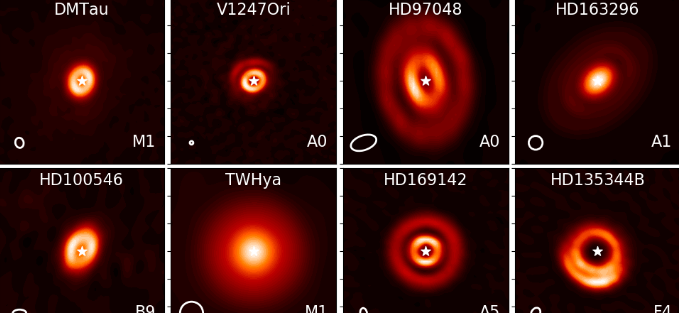Protoplanetary disk gaps throughout the ages
Protoplanetary disk gaps throughout the ages
NRC-Herzberg and UVic astronomers used ALMA archival data to study the gap structures in a large sample of protoplanetary disks and came to new conclusions regarding their origin.
The Atacama Large Millimeter/submillimeter Array (ALMA) in the Atacama desert in Chile has proven to be a revolutionary telescope, particularly in the field of planet formation. Its unprecedented resolution of a fraction of an arcsecond finally allows astronomers to zoom in into the birth cradles of planets: the protoplanetary disks of gas and dust around young stars. The study of structures in these disks provides valuable insights into the questions of where, how and when planets form.
A few years ago ALMA astonished the world with an incredibly detailed image of the disk around the young star HL Tau. Rather than a smooth circular shape, as disks were thought to be at the time, it turned out that the HL Tau disk consists of many narrow rings and gaps. This morphology sparked a heavy debate within the planet formation community: are all these gaps carved by planets? The young age of the system cast doubts on this interpretation and several other theories of how gaps could be generated were proposed.
In the following years, many other disks were imaged at high resolution with ALMA, and it turned out that HL Tau was not unique at all: in fact, every disk showed the presence of at least one ring. However, astronomers generally focused on one disk at the time, usually their favorite target of study. A large sample of disks from a large variety of stars, which would allow for proper comparisons and statistical analysis, was missing.
Last year, NRC-Herzberg postdoctoral fellow and ARC member Dr. Nienke van der Marel decided to tackle this issue by turning to the ALMA archive. New ALMA data are difficult to obtain due to the high number of people wanting to use the telescope – typically only one in five proposals from North America are accepted - and a wait time of up to 18 months for the data to be received after a successful proposal. However, the ALMA archive contains all ALMA observations that have been taken in the past 6 years. Data become public one year after delivery to the group that originally requested it, so that the general astronomy community can use it.
Dr. van der Marel scoured the ALMA archive for any protoplanetary disks showing multi-ring structure and found 16 examples. The stars associated with these disks ranged from 40 times the brightness of the Sun down to just 1/5th of its brightness, and varied in age from 500 000 to 15 million years old. Dr. van der Marel computed the gap locations for each of the disks, and then used the most up-to-date distances of the stars from the April 2018 Gaia Data Release to accurately determine their properties. She then looked for correlations between the stars’properties and their gap locations.
The analysis led to a number of interesting conclusions. First of all, the gap locations did not show any clear correlation with so-called snowlines: the distance from the star where molecules freeze out, creating favorable locations for dust growth. While this result has been shown in other work, this study confirmed the lack of correlation for a wide variety of stars. Second, gaps were present in all systems from young to old, and the gap properties, such as width, did not appear to change with age. This means that whatever creates the gaps is a long-term process. Finally, the older disks in the sample were much smaller than their younger counterparts, suggesting that disks disperse from the outside inwards.
The publication summarizing the results, authored by ARC members Nienke van der Marel, Ruobing Dong (UVic), James di Francesco (NRC-Herzberg) and other collaborators, was recently accepted by the Astrophysical Journal:
Dr. Nienke van der Marel (NRC), Prof. Ruobing Dong (UVic), Dr. James di Francesco (NRC), Prof. Jonathan Williams (University of Hawaii) and Dr. John Tobin (NRAO) – “Protoplanetary disk rings and gaps across ages and luminosities” (ApJ, 2019, in press)

